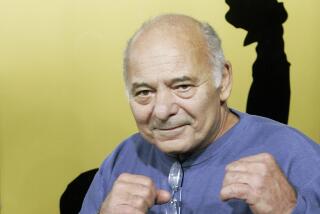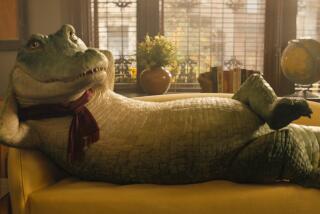Burt, the hot-tempered croc from ‘Crocodile Dundee,’ dies at 90

- Share via
Burt, the saltwater crocodile who rose to fame through the 1980s action comedy “Crocodile Dundee,” has died.
The hot-tempered but cold-blooded animal actor, who was estimated to be about 90, “passed away peacefully” over the weekend, according to Crocosaurus Cove, the Darwin, Australia-based aquarium and exhibition center where he was housed. The organization announced the reptile’s death Sunday on social media and said that it marked “the end of an incredible era.”
Paul Hogan is the amiable actor who does those Come to Australia TV commercials.
“Burt’s life story is one of strength, resilience, and a personality as bold as the Top End itself,” the aquarium’s statement said, referring to the country’s rugged northern territory. “Captured in the 1980s in the Reynolds River, Burt became one of the most recognised crocodiles in the world, appearing in Crocodile Dundee and helping to shape Australia’s image as a land of rugged natural beauty and awe-inspiring wildlife.”
Burt was estimated to be more than 16 feet long, slightly longer than the average male of his species, the Associated Press reported.
Burt co-starred with the amiable Aussie Paul Hogan in the Australian-American fish-out-of water comedy about Mick Dundee, a crocodile-poaching bushman made famous after allegedly losing his leg to a hostile croc (spoiler: he didn’t) in a savage reptile encounter. In the Peter Faiman-directed film, which was released in Australia in 1985 and in the U.S. in 1986, a glamorous American reporter (Linda Kozlowski, who later married and divorced Hogan) brings the Australian adventurer to New York City, where he has to test a new slew of survival skills.
Paul Hogan, a.k.a.
Hogan, who has been credited with single-handedly boosting Austrialia’s tourism with his “Come to Australia” TV commercials in the 1980s, informally continued that campaign by co-writing and co-starring in the film, further endearing himself to international audiences as the self-described “folk hero.” “Crocodile Dundee” became and remains Australia’s highest-grossing homegrown movie, raking in $47.7 million (Australian), and spawned two sequels, 1988‘s “Crocodile Dundee II” and 2001‘s “Crocodile Dundee in Los Angeles.” The first film became the most commercially successful Australian film ever made and is one of the most successful non-Hollywood films of all time, according to the National Film and Sound Archive of Australia.
For his part, Burt was described as “a fierce and fascinating ambassador for crocodile education” since making his way to Crocosaurus Cove in 2008. The croc was independent and apparently a “confirmed bachelor,” a characteristic he made clear “during his earlier years at a crocodile farm,” the cove said.
If you’ve seen the film, now could be the time to get into the act.
“His fiery temperament earned him the respect of his caretakers and visitors alike, as he embodied the raw and untamed spirit of the saltwater crocodile,” the statement said, noting that he served as a reminder of the “the power and majesty of these incredible creatures.”
“While his personality could be challenging, it was also what made him so memorable and beloved by those who worked with him and the thousands who visited him over the years. Visitors from around the globe marveled at his impressive size and commanding presence, especially at feeding time,” the cove said, adding, “As we mourn his loss, we are reminded of the vital role wildlife plays in our shared history and the importance of preserving it for future generations.”
Crocosaurus Cove plans to memorialize Burt with a commemorative sign at the attraction, which boasts the world’s largest display of Australian reptiles and some of the largest saltwater crocodiles in the country.
More to Read
Only good movies
Get the Indie Focus newsletter, Mark Olsen's weekly guide to the world of cinema.
You may occasionally receive promotional content from the Los Angeles Times.











